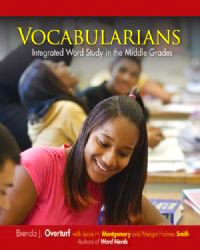Bring Word Nerdiness to the Middle Level
Vocabularians: Integrated Word Study in the Middle Grades
By Brenda J Overturf with Leslie H Montgomery and Margot Holmes Smith
(Stenhouse Publishers, 2015 – Learn more)

Brenda Overturf’s Vocabularians is an extension of her earlier book Word Nerds, the ultimate how-to guide for elementary teachers who wish to ignite the love of words in their students. Overturf decided to write Vocabularians in response to middle level educators (grades 5-8) who, having been inspired by the strategies introduced in Word Nerds, asked, “But what about us?”
At the heart of Vocabularians is the earnest belief that “…when we enrich our classrooms, hallways, and common areas with remarkable and intriguing words, we show we love words no matter where we are. And when adults and peers love words, students learn to love them, too.”
Both instructional and engaging

The book is both instructional and practical, and I’d argue it’s most successful when it focuses on the latter. The instructional information is spot on, but as one might expect, dry. The practical examples and anecdotes are engaging and interesting, and the teaching authenticity creates a bond between reader and author—we feel that “she gets it” because the classroom is always in the forefront.
We all have students whose light bulb moments are the reason we continue to search for new ways to reach them, and in Overturf’s case, she mentions a student named Kerrigan.
In true student-centered fashion, Overturf gives Kerrigan the last word on the impact these strategies have on learning: “Then we started on projects like drawing pictures with the letters in it or finding colors that kind of go with the word, and it’s like a really neat idea that somebody thought of to make it fun!”
Much of the book is devoted to finding ways to personalize learning, a strategy that goes a long way, not just in the teaching of vocabulary, but in differentiating for student success across the board.
Full middle school vocabulary immersion can work!
Interestingly, I think a second way to utilize this book is to view it as a model of full-school vocabulary immersion. As many middle school teachers will attest, it often feels like the entire school expects the ELA classroom to be the singular location of word study and vocabulary acquisition (the special vocabulary of science, history, math, et al notwithstanding).
However, at the center of this book is the belief that not only is the entire building responsible for vocabulary instruction, but the goal of shared instruction is to “become a word-learning community.” Obviously this is music to ELA teachers’ ears, but this book validates that the middle school schedule makes integrated vocabulary instruction very difficult. With that in mind, the book offers several practical activities that are cross-curricular, as well as several suggestions of how to begin.
It would be tempting to minimize the complexities of a middle school and the impact that logistics, scheduling, and content demands have on vocabulary instruction, but the beauty of this book is that it doesn’t do that. Instead, it marches bravely on, encouraging teachers to forge ahead, despite the multitude of challenges we face.
In the Epilogue, there is an honest assessment that implementing integrated vocabulary is not a one-shot deal. Overturf explains, “No matter how solid your plan is, you will almost certainly want to revise it as you and your students learn more.”
Have your markers ready!
The book’s best feature by far is the authentic examples and strategies that are included. I’m one of those people who can’t read without marking up the book. As I look back at my notes, I find that I also underlined the inspirational—“We have to make our classrooms a place where it is acceptable and encouraged to take academic risks and become word conscious together.” I have huge stars next to activities that I plan to implement myself: “The Hot Seat,” “Word Colors,” and “Vocabulary Rock and Roll.”
Vocabularians is worth reading for many reasons, but who couldn’t use a dose of inspiration and a few go-to strategies?
Preview the entire book at the publisher’s website
Amber Rain Chandler is a National Board Certified ELA teacher and education writer in Hamburg, NY. She leads professional development in Project-Based Learning, Danielson’s Domains, and Differentiation. Follow her on Twitter @MsAmberChandler and visit her website, AmberRainChandler.com.




































